History
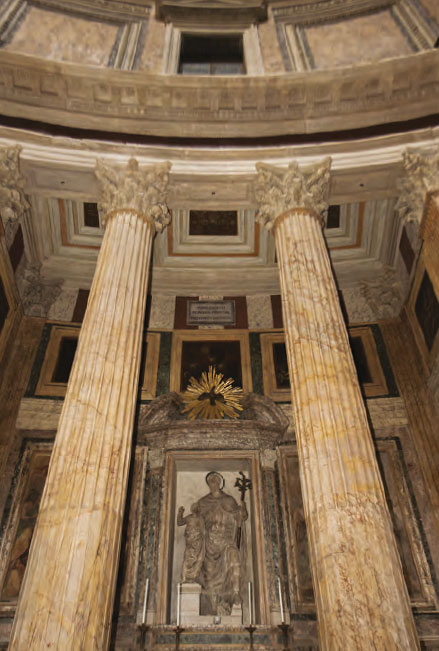
Founded in 1542 under the vault of the Pantheon, the Pontificia Accademia dei Virtuosi al Pantheon, originally called the Compagnia, inaugurated its activities on January 1, 1543. The headquarters was the first chapel on the left in the Pantheon, dedicated to its patron Saint Joseph. It was the first association of artists in Rome, authorized by Paul III, who effectively put an end to the medieval legal statutes of individual guilds: all artists might belong to one society. The leading artists of all periods since, including foreigners, have belonged to it: Francesco Mochi, Pietro da Cortona, Velazquez, Borromini, Vanvitelli, Canova, Valadier. A few years after its foundation, musicians were also co-opted into the Company. Their activity consisted of religious practices and works of charity. In the second half of the nineteenth century, thanks to a legacy from a member, Ludovico Stanzani, a bursary system was established, under which young artists were trained. In 1995, Pope John Paul II added the Class of Men of Letters and Poets and the category of Filmmakers to the already existing Class of painters.
The Company of Saint Joseph of the Holy Land
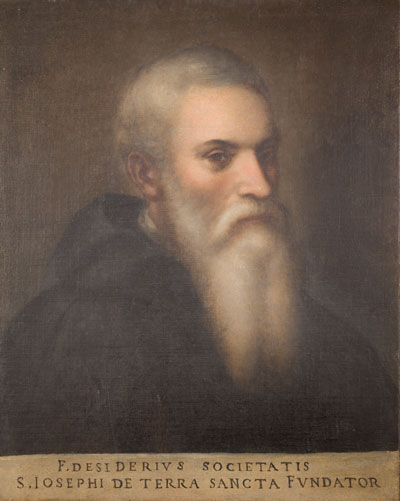
The founder of the Pantheon congregation, originally called the Compagnia di San Giuseppe di Terrasanta, was the Cistercian monk Desiderio d’Adiutorio (1481-1546), Piombatore delle Bolle Apostoliche [maker of lead seals for papal bulls]. The Pantheon collection holds a portrait of 1591 (?) of the monk, a work debatably attributed to Francesco Terzi, since in terms of quality it seems to belong more to Roman portraiture of the first half of the sixteenth century[1], than to the characteristic hand of that painter.
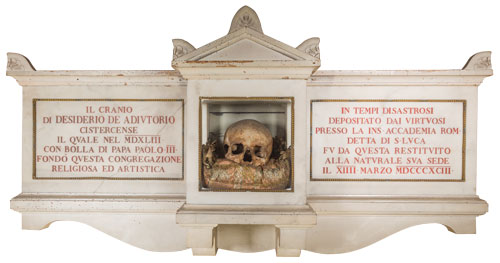
The designation of the Compagnia di San Giuseppe di Terrasanta derives from the chapel of that name, first on the left in the edifice in Piazza della Rotonda, assigned in patronage to the Virtuosi, as they were described by Giovanni Baglione a few decades later. The chapel was built at the behest of Desiderio d´Adiutorio to store a quantity of soil that he had brought back from Palestine. The presence of the soil under the altar of the chapel elevates it as emblem both on a moral and religious level, as well as consecrating it as venue for the gatherings of the Virtuosi. A venue held in high esteem by the associated artists, as made clear by the decorations and the cyclical restorations made: interventions performed not least out of charity. During the 17th century, in fact, the following gave paintings: Giovanni Baglione (perhaps), Francesco Cozza, Francesco Rosa, Ludovico Gimignani, Giovanni Andrea Carloni, Giambattista Greppi, Giovanni Antonio Carosi; while the bas-reliefs by Paolo Benaglia and Carlo Monaldi date from the eighteenth century.
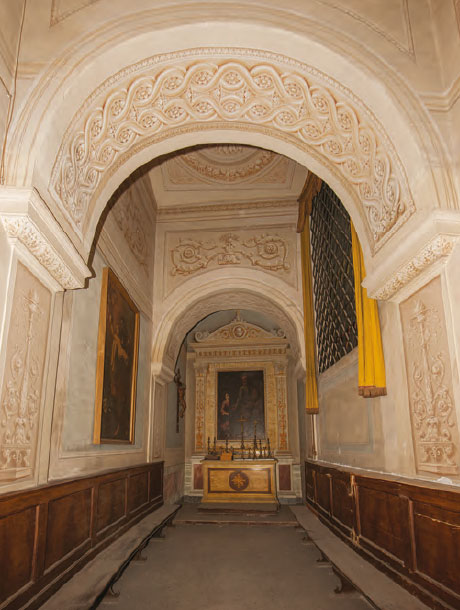
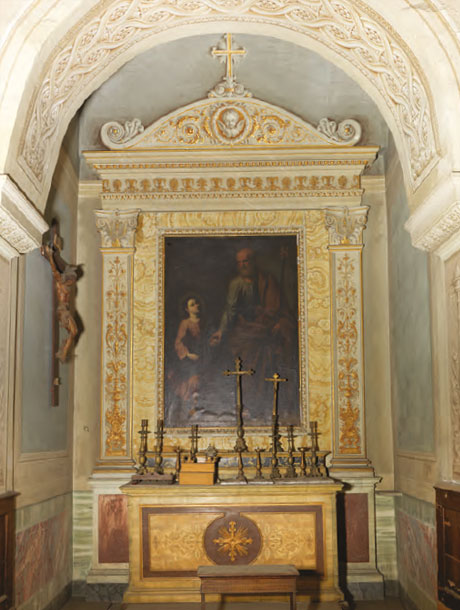
In fact, it should be specified that the actual venue of the monthly meetings of the artistic community, to celebrate the sacred liturgy and discuss the agenda, was what is known as the “oratorio delle riunioni”, halfway up the staircase leading to the attic floor of the Pantheon. As a result of the expansion of the collection, following donations or the arrival of works from the architecture, painting and sculpture competitions, Cardinal Agostino Rivarola, in a response dated 1839, granted the Virtuosi use of the rooms on the attic floor of the Pantheon.
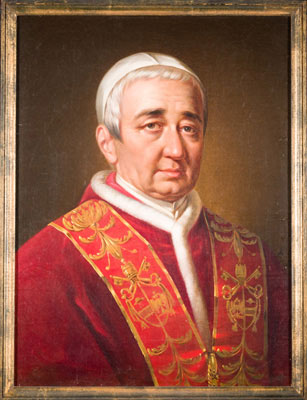
Towards the definition of the Academy:
the competitions and the figure of Raphael
During the 1830s, certain events occurred that give greater thrust to the congregation's activity. The first impetus came in 1837 with the publication of the new Statute, which made possible the inauguration of two types of competitions among artists: bi-monthly, called exercises, or biennial, called Gregorian, in honour of Gregory XVI, protector of the Virtuosi.
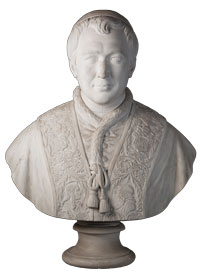
di Ignoto (1846)
The establishment of competitions was determinant in raising the status of the Congregation to that of Academy. The themes chosen for the competition themselves confirm this orientation. The main subjects, in fact, inhered to classical mythology, history, the Holy Scriptures, and hagiography. In the architecture competitions, however, there was greater adherence to actuality. It was no coincidence that the projects invited were for the construction of religious and secular buildings of public utility. To attain the status of Academy, greater openness of the institution to new appointments from other cultural and social sectors was added to its didactic activity.
The title Pontifical was granted by Pius IX in 1861 but Academy status came only on May 9, 1928 on the proposal of Cardinal Pietro Gasparri to Pius XI, who endorsed the petition.
A second event of great importance for the history of the Company was the identification in 1833, in the Pantheon, of Raphael's tomb. It was an event that endorsed a sort of direct descent from the Urbino painter, one already marked by the presence of numerous Raphaelesque disciples and artists, among them Tommaso Minardi and Friedrich Overbeck. Raphael's tomb embodies a further symbol and reason for recognition of the imperishable value of artistic beauty.
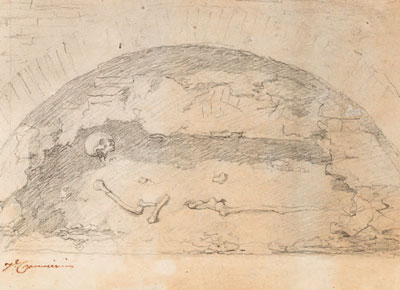
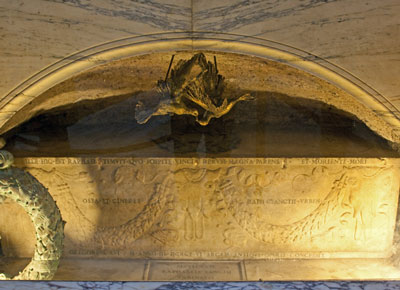
The Virtuosi
The history of the Congregation of the Virtuosi is resonant with many high-sounding names and other lesser ones which, nevertheless, testify to the cultural fervour of succeeding times. The first decades saw the names of numerous artists of excellence, including: Camillo Mariani, Nicola Cordier, Guglielmo Della Porta, Daniele da Volterra, Scipione Pulzone, Francesco Salviati, Paris Nogari, Lorenzo Sabatini, Pietro Roviale, Girolamo da Carpi, Il Cavalier D'Arpino, Pirro Ligorio, Bartolomeo Baronino, Jacopo Barozzi da Vignola, Flaminio Ponzio, Martino Longhi, Ottaviano Mascherino. But it was above all in the seventeenth and eighteenth centuries that the most prestigious names were listed, artist such as: Giovanni Baglione, Orazio Borgianni, Carlo and Girolamo Rainaldi, Alessandro Algardi, Francesco Mochi, Francesco Borromini, Diego Velazquez, co-opted during his Roman stay in the mid-seventeenth century; and again, Mattia Preti, Pietro da Cortona, Giovanni Francesco Romanelli, Giovanni Lanfranco, Carlo Maratti, Giacinto Brandi, Giambattista Gaulli, Claude Lorrain, Jean Miel, Sebastiano Conca, Corrado Giaquinto, Giuseppe and Pier Leone Ghezzi, Pompeo Batoni, Camillo Rusconi, Filippo Juvarra, Alessandro Specchi, Luigi Vanvitelli, Giuseppe Valadier. Finally, in the nineteenth century the names are listed of: Antonio Canova, Pietro Tenerani, Vincenzo Camuccini, Tommaso Minardi, Francesco Podesti, Jean-Auguste-Domenique Ingres, Giuseppe De Fabris, Salvatore Bianchi, Luigi Canina, Andrea Busiri Vici.
Clearly not all those mentioned took part in the life of the Academy to the same extent, but certainly Giovanni Baglione (c. 1566/1568 - 1643) was a staunch supporter and animating force, coming into contact with the Company around 1600. From him, thanks to his ability to make acquaintanceship, came the suggestion to welcome among the ranks of Virtuosi artists of the calibre of: Claude Lorrain, Giovanni Lanfranco and Pietro da Cortona, and figures such as Giovanni Bellori; as well as the Spanish canon from Pamplona, Bernardo Cegama. Some portraits by Baglione survive, as do some works with St. Joseph as their subject; the same theme can also be found in Giacinto Brandi and in Domenico Ambrosini’s San Giuseppe con Jesù. An important contribution to the theme of the early Christian martydom came from some former beneficiaries of the “Stanzani bursary”, such as: Tullio Salvatore Quinzio, Arturo Noci and Alessandro Pigna. A nucleus of works, noteworthy among others, is the production of the Galli family, in particular that of the Neoclassical sculptor Pietro, most of which are Hellenistic in inspiration.
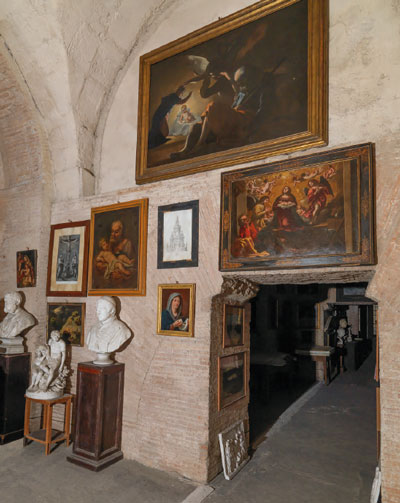
The Collection
The general collection of works of art was not shaped by a market dynamic or commissions of any nature, but by the artist's magnanimity and desire to donate and pay homage to the Company. In addition, the Virtuosi, in every period, have devoted themselves to charitable works for the less well-off, in particular to the fate of fellow artists and their families.
At present the collection is spread over two sites, with different legal appertinence. The historical and more substantial nucleus, including paintings and sculptures from the 16th to the 20th century, 19th-20th century drawings and furnishings, is kept in the Pantheon; the sector of more recent production, on the other hand, has been in Via della Conciliazione since 2008, where the library and archive are also located.
[1] Cfr. A. Capriotti, Francesco Terzi, in V. Tiberia, La Collezione della Pontificia Insigne Accademia di Belle Arti e Lettere dei Virtuosi al Pantheon, Tivoli, Scripta Manent, 2016, pp. 34-35.

